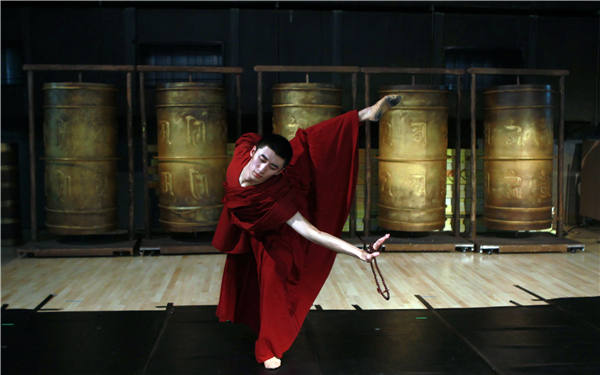
Photo provided to China Daily
A production by an ethnic music troupe, titled Tsangyang Gyatso, aims to shine the spotlight on a legendary spiritual leader. Chen Nan reports.
The taste for romantic poems and love songs written by Tsangyang Gyatso (1683-1706) never seems to go away. Yet few know much about the legendary sixth Dalai Lama, who lived for just 23 years. A dance drama by the China Ethnic Song and Dance Ensemble, titled Tsangyang Gyatso, aims to delve into his personal life apart from his religious and political identities. It will be staged in Beijing in the last weekend of the month. Director Ding Wei says he knew almost nothing about Tsangyang Gyatso besides his artistic work until he started to prepare for the performance a year ago.
"That's true of many people, including the cast and creative team behind this show. We want to introduce this legend as a human being, who had to deal with life as we do," Ding says.
The idea of the dance drama came from Ding, who has been working with the ensemble for decades. It's the first dance show by the ensemble in its 63-year history.
Since it was founded in 1952, the ensemble's main job has been to perform for people living in remote regions across China, Ding says.
"We want to produce a dance drama which represents us," he says.
"The ensemble has performed in the Tibet autonomous region many times. We'd heard lots of stories about Tsangyang Gyatso and we were surprised to find that he is still an icon among the Tibetan people today. His legacy goes far beyond his poems and love songs."
Ding invited Danzhu Angben, a Tibetan scholar with the Minzu University of China, to be the art consultant for the show and to also contribute to the script.
Tsangyang Gyatso was identified as the new incarnation of the Dalai Lama at age 14.
During his research, Ding found that as a teenage boy, Tsangyang Gyatso was also eager to live a free lifestyle.
He preferred ordinary clothes rather than a monk's long robes, and typically meandered through Lhasa's streets, talking to many people.
Ding says: "When I visited Potala Palace, I couldn't help wondering about the life of Tsangyang Gyatso there. He was just a young man who loved nature and hoped to live an ordinary life."
To create authentic Tibetan music and dance, Ding led the production team earlier this year to visit the northwestern provinces of Qinghai and Gansu, where many Tibetans live.
They went to Luqu county of the Gannan Tibetan autonomous prefecture in Gansu to watch a Guozhuang dance contest, a major Tibetan folk show, which has nearly 2,000 people dancing in a circle.
In September, they went to Lhasa, visiting Potala Palace, where they saw a grand ceremony, celebrating the 50th anniversary of the region's founding.
"We were excited to enjoy Tibetan dances and music, which are rarely seen. We also borrowed some of those elements for this dance drama," says Ding.
Three young actors were chosen from hundreds of candidates to play the role of Tsangyang Gyatso as a teenager and young adult in the show.
Dancer Huang Chendi, 20, is one of them. Having never closely seen Tibetan communities before, he stayed at the Labrang Monastery, in Xiahe county, in the Gannan Tibetan autonomous prefecture, for weeks, living with Tibetan monks.
Fei Bo, resident choreographer of the National Ballet of China, was invited to choreograph the dance drama. Known for his collaboration with famous dancers, such as Tamara Rojo, lead ballerina and artistic director of London's Royal Ballet, where his choreography include Hamlet, Fei says he is fascinated by the story of Tsangyang Gyatso.
After its debut performance in Beijing on Dec 27, the dance drama will tour the rest of the country next year.





